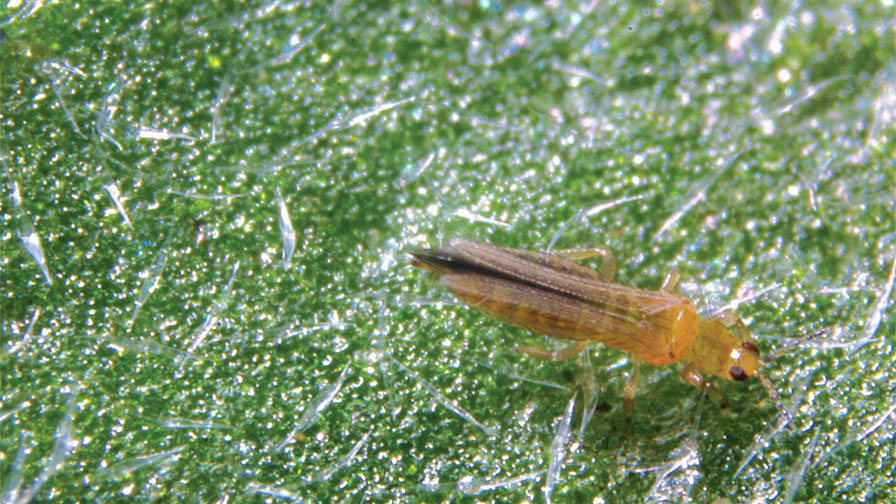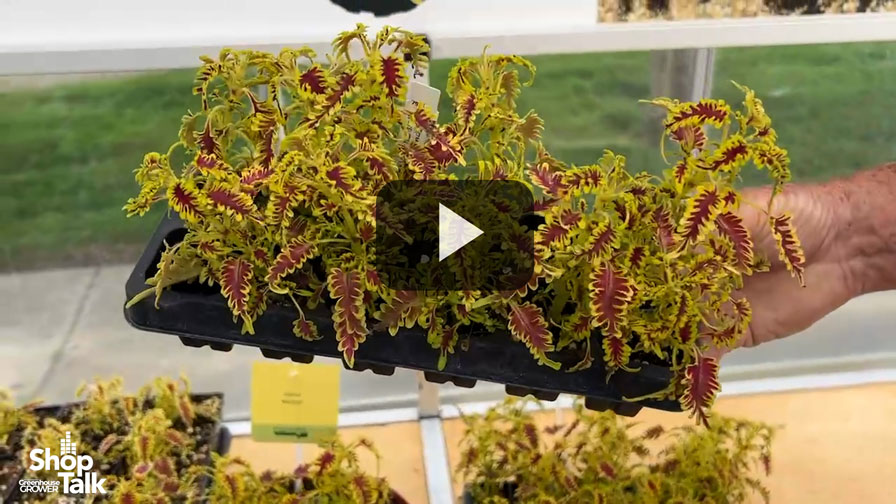Tips to Stay Ahead of Aphids, Mites, and Thrips

Avoid thrips resistance by rotating chemicals so that two successive generations are not exposed to the same product.
Aphids, mites, and thrips are three major sap-feeding pests that can exact a huge financial toll on spring crops. As temperatures rise and benches fill with fresh plant material for spring sales, these pests build their numbers for the seasonal buffet served under the plastic of our greenhouses. To protect the economic promise of spring crops, stop the feeding and interrupt the life cycle of the pests before significant crop damage occurs.
To maintain pesticide efficacy year after year, we must rotate the modes of action (MOA) used so two successive generations of pests aren’t exposed to the same product or the same MOA. New MOA classifications are created as necessary for chemicals with unique target sites in pests. Each new MOA expands the possible rotations that can be made for a specific pest. Recent chemical introductions for The Big Three of spring — aphids, mites, and thrips — have added two new MOAs (Mainspring and Sultan) and a new chemistry, classified as 9B (Rycar).
The MOA category UN is used when the target protein in the insect or pest has not been characterized. MOA UN contains azadirachtin, and is found in all of the microbial insecticides such as BotaniGard, Grandevo PTO, Met 52, and Preferal, and defined chemicals such as Overture. Microbial insecticides with MOA UN activity are excellent in rotation with traditional chemistries because they provide effective control and reduced risk of resistance.
Aphids
Mainspring, with a new MOA 28, and Rycar (MOA 9B) with its new chemistry, are effective aphid controls. Mainspring is a systemic that can be drenched for aphid prevention. Rycar provides contact and translaminar control as a spray. These new products join Kontos (MOA 23), MOA 4A products Flagship, Safari, TriStar, and Marathon and Endeavor (MOA 9B) as some of the most effective chemicals against aphids. Effective microbial products for aphids include Grandevo PTO, BotaniGard, and Preferal. Each of the microbials can be tank-mixed with an azadirachtin product such as AzaGuard EC, Azatin O, or Molt-X for added control.
Thrips
Mainspring provides a drench application alternative to Kontos for western flower thrips. Rycar spray provides a new tool against the voracious chili thrips. These products join the older chemistries Pylon (MOA 13), Avid plus Azatin (MOA 6+UN), Overture and Kontos (drench only) as some of the best weapons in the chemical arsenal against thrips. Microbial weapons in the arsenal include BotaniGard, Grandevo PTO, Met 52, and Preferal; addition of an azadirachtin pro-
duct is recommended.
Spider Mites
Sultan (MOA 25) is a new class of chemistry that’s proving to be very effective against all life stages. Use Sultan in rotation with Floramite (MOA UN), Shuttle O (MOA 20B), Sirocco (MOA 6+UN), or Kontos in the battle with mites. Microbial products effective on spider mites are Grandevo PTO and Preferal. Always check the label for activity when treating other mite species.
Consider some additional information when working with microbial products. BotaniGard, Met 52, and Preferal are sold as formulations of the fungal spores, which can be fogged, sprayed, or drenched. The spores contact the insect host and germinate. The fungus invades the exoskeleton, growing and resulting in death within a few days. The efficacy of these pesticides and their persistence in a crop is affected by temperature and humidity, so maintain as much humidity as is feasible for several hours after treatment. In a humid greenhouse environment, residual activity can last two weeks. Grandevo PTO is a bacteria-based product that works through multiple mechanisms, acting as a stomach poison, reducing reproduction rates, and repelling insects.
The microbials listed here work primarily through contact; use a surfactant, such as CapSil, when spraying to obtain thorough coverage. Tank-mixing with an azadirachtin insect growth regulator is recommended, unless only mites are being targeted. Grandevo PTO, BotaniGard, and Preferal are compatible with most chemical insecticides, but are largely not compatible with most fungicides. Preferal is compatible with copper products, but shouldn’t be used within five days of other fungicides. Grandevo PTO can also be tank-mixed with BotaniGard or Preferal. Contact GGSPro for tank-mix recommendations. Many of these products are OMRI-registered (Organic Materials Review Institute). For growers using biological control agents (BCAs), these microbial products tend to be compatible with beneficial insects and exhibit good bee safety. Check with your supplier before using any insecticide with a BCA program.
To learn more about aphid and thrips control, check out the following articles:
• How to Stop Aphids in the Greenhouse
• How Greenhouse Growers Can Manage the Foxglove Aphid
• Why It’s Important to Stay One Step Ahead of Thrips
Always read and follow all label directions. Products other than those mentioned here may also be safe and effective.









